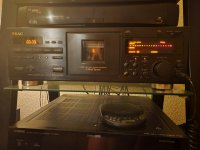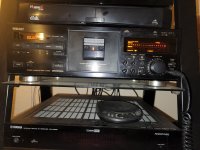Dolby levels may be standard but tapeheads sensitivity and output voltage from the first playback amplifier stage apart from being different from deck to deck, ends sometimes in different filters or filter configuration .Sometimes there's a second stage then the bias trap then the tape type corrections...it does differ from deck to deck and sometimes you get different results.There's also a third op-amp amplifying stage in the dolby chip to help equalize the dolby levers.Yamaha kx 990 and nad 6300 used that playtrim in their advantage not only to equalize tapeheads wear but also to deliver equal dolby levels with unequal playback levels on each channel .The best match i found between different decks for dolby c encode decode algorithm was pioneer ct 777 and technics rs az7 although they used different dolby chips from Toshiba and sony...and not all dolby chips were born equal...
My Nak ZX-7 had an azimuth adj to be used when recording. I'd do that and the bias level adjustment whenever I recorded. It was quite good. I still have the deck but the rollers are so dry it eats tape now, so it is in the closet.Any noise reduction system requires that the deck is aligned correctly because the way noise reduction works (using frequency dependent compression and expansion or companding) means that it is extremely sensitive to errors.
Slight head alignment or azimuth errors between decks will produce significant treble roll off. Also critical is the play back level of the signal entering the decoder if playing back a tape recorded on a different machine.
A correctly aligned deck whether using Dolby B or C should play back its own recording with absolutely correct tonal balance on the deck it was recorded on. It is unfortunately a fact that decks from different manufacturers seldom meet that requirement but on a diy level you can usually align a second deck to 'match' another so that there is pretty good compatibility. Azimuth and correct levels (the internal preset playback and preset record sensitivity levels are the most important things.
Have a trash find Technics dual cassette deck that works fine. I'm 62 and all my first music purchase was on cassette or 8 track. Some will have to look that one up. Remarkably I kept most. Alot of stuff we recorded from radio. Stuff I don't even know what it is. Will also pick up tapes at thrift stores for nothing. Tom Petty girl on LSD last year. Wierd stuff you come across. Pun intended. Hope gears hold up. Like you said 3D printer copy. Friend has one. Just cool that the old stuff was built to last. We just had to have a cheap cassette player rigged on our dash. MichaelYes I also have worked with those Technics Series Dual Decks & they have the notorious gear fracture. Disables a lot of those decks. A good 3D print should be in order
And de-magnatized!Don't forget that the heads also need to be clean.
I am using occasionally, a Sony TC-K555. Dual capstan, no auto-reverse. Meaning, constant tension on the tape segment between said two capstans. Take that, Revox and Nakamichi! lol
I run this through my HK495i and Boston Acoustics A100 speakers. For daily LP spinning, an Akai AP-100C with ortofon cartridge. Fear my eighties power audio reproduction capabilities.

I run this through my HK495i and Boston Acoustics A100 speakers. For daily LP spinning, an Akai AP-100C with ortofon cartridge. Fear my eighties power audio reproduction capabilities.
Golden days. All Made in Japan quality products. Akai,Sony,Toshiba,Aiwa,JVC,National,Panasonc,Technics,Sansui,Nakamichi,Sanyo,Pioneer,Yamaha,Onkyo ... may be i have left few more. Legacy Lost....
The higher end nak's had dual capstan. Mine does.I am using occasionally, a Sony TC-K555. Dual capstan, no auto-reverse. Meaning, constant tension on the tape segment between said two capstans. Take that, Revox and Nakamichi! lol
I run this through my HK495i and Boston Acoustics A100 speakers. For daily LP spinning, an Akai AP-100C with ortofon cartridge. Fear my eighties power audio reproduction capabilities.
View attachment 1075944
Same here, my systems, with the exception of my 2005 HK DVD player, are all Japan-born, or American, or built by me.Golden days. All Made in Japan quality products. Akai,Sony,Toshiba,Aiwa,JVC,National,Panasonc,Technics,Sansui,Nakamichi,Sanyo,Pioneer,Yamaha,Onkyo ... may be i have left few more. Legacy Lost....
Sony TC-KA7ES as well as my KA3ES are dual capstan with BLDC direct drive on the take up side of the mechanism, supply side is belt driven by a large, flat belt. 3 motor mechanism, but one of the motors is used to configure the mechanism for different modes. The flywheels are large and heavy and dynamically balanced. 3 heads, calibration controls, metal tape and Dolby S.
I had a Pioneer CTF-1000 dual capstan, two motor and a number of solenoids. Gave this one to a friend after overhaul and boredom set in. That machine was a mess and took a long time to sort out. Stupid plastics... (idlers, and clutches)
I had a Pioneer CTF-1000 dual capstan, two motor and a number of solenoids. Gave this one to a friend after overhaul and boredom set in. That machine was a mess and took a long time to sort out. Stupid plastics... (idlers, and clutches)
Bit of a Nakamichi fan here - PA-7 / CA-5 amp/pre - so naturally need a few cassette players - top is an excellent RX-505(with original remote) and a BX-300 in my main setup and a LX-5 and RX202 in an office setup. Also do digital and LP - one nice aspect of the cassette decks is the LOW cost of prerecorded cassettes - often you can find them in excellent condition for as little a $1-$2 - compared to older LP - often several time higher - but almost always with the pops and clicks - yes older cassettes may have some drop off in higher frequencies but for general listing not a problem - just picked up Nak MB-1 CD Player (their TOL unit) it has a unique DAC board - never been able to get specs on it - but its output - about the best I have heard.
I am having a Teac V-5000 from ebay which works with a slight problem.
I have an older Sony KA1ESA which has a logic control problem, replaced 2 belts but I can't get the door to close. I havent repaired it yet.
I wonder if it worth a repair. It's a year 1999 or 2000 model. It played and recorded satisfactorily until about 1 year ago.
I have an older Sony KA1ESA which has a logic control problem, replaced 2 belts but I can't get the door to close. I havent repaired it yet.
I wonder if it worth a repair. It's a year 1999 or 2000 model. It played and recorded satisfactorily until about 1 year ago.
Attachments
A Service Manual would be a good tool for troubleshooting problems.I am having a Teac V-5000 from ebay which works with a slight problem.
I have an older Sony KA1ESA which has a logic control problem, replaced 2 belts but I can't get the door to close. I havent repaired it yet.
I wonder if it worth a repair. It's a year 1999 or 2000 model. It played and recorded satisfactorily until about 1 year ago.
Available here, you just need a (free) registrationA Service Manual would be a good tool for troubleshooting problems.
https://www.hifiengine.com/manual_library/teac/v-5000.shtml
Thank you for the tip, Sir. I am printing the service manual now. Greetings from California!Available here, you just need a (free) registration
https://www.hifiengine.com/manual_library/teac/v-5000.shtml
I have two of these cassette decks (though non Denon) having chrystal or S-ferrite heads. They can last forever, as the material used in the heads is extremely hard.What a Joy to read this thread. I always liked making recordings of my favourite Radio programs.
Party Tapes for instance. And collections of my favourite musical numbers to be gifted to friends.
I know, copyright and all that. Artists deserve to be paid.
What I saw in Cassette Tapes was a possibility to reverse Time Distortion. A severe problem in Analog Recording.
How did the Audio industry sell us a poor idea from a good one? I think I shall consult the audio expert about reviving Cassette Tapes in my Household.
After all, we thought Vinyl was dead and buried. But I always liked it in terms of resolution.
Ralph, thank you. I downloaded the manual. I opened the case, and what I saw was a monstruosity! 🙂 This cassette deck is built like a tank.Available here, you just need a (free) registration
https://www.hifiengine.com/manual_library/teac/v-5000.shtml
Not to mention that in order to access the head mechanism you need a lot of dismantling. I decided I dont continue. I opened a top plate assy which covers the cassette hole sensors (the cassette type selector), but I didn't continue past it. The take up spindle is driven by its electric motor via a clutch. Why it stops roating, I don't know. It's like the motor suddenly stops turning. I could try to see if the motor receives power when the spindle stops rotating, but I didnt do that.
I tried to make a search online for this kind of erratic operation, and one of the answers was, clean the heads??
What is happening is that by the middle of cassette playing the take up spindle stops rotating, randomly and then the machine senses the thing and stops.
If I try to clean the heads with a non abrasive special cleaning cassette soaken in alcohol, then the problem somehow disappears. I believe this has to do either with the take up spindle motion sensor, or there is something else, but I dont think I will send it to repair, or try fixing it myself.
Clean the pinch rollers, capstan etc.
A drop of thin lube suitable for the materials used would also help in sticky mechanisms.
A drop of thin lube suitable for the materials used would also help in sticky mechanisms.
All is clean and rotating freely. There is nothing to lubricate. It's just the take-up spindle which stops rotating, randomly. It looks like either a control problem, or the electric motor which is driving that spindle, stops rotating. I cannot understand why. I cannot figure it from the service manual.
- Home
- Source & Line
- Analogue Source
- How Many Cassette Deck Users Here?

